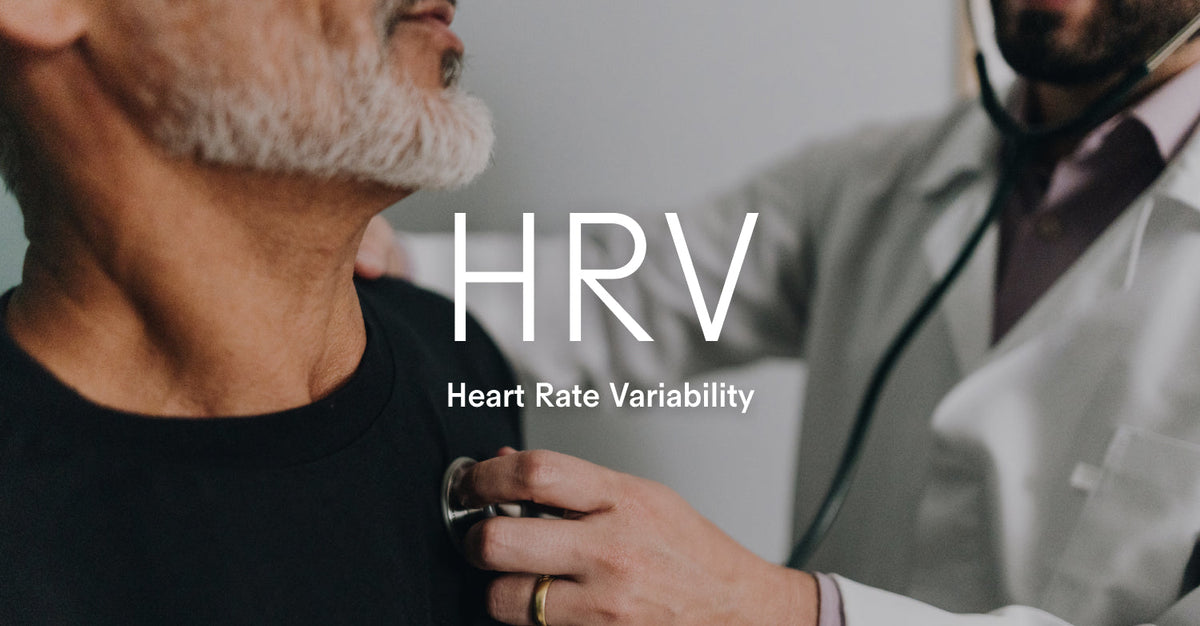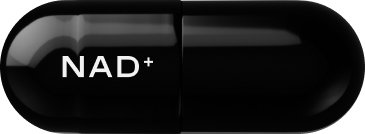

When was the last time you thought about your heartbeat? This daily phenomenon tends to slip by unnoticed; still, our hearts diligently beat over 100,000 times a day and more than 2.5 billion times in the average lifetime [1]. However, a potentially more fascinating insight into our health may lie within something seemingly negligible—the spaces, or intervals, between heartbeats, also known as heart rate variability (HRV). These intervals reflect how heart beats vary over time, providing important information about our physiological state.
Heart rate variability is a physiological process involving the autonomic nervous system. The sympathetic and parasympathetic systems regulate the fluctuations in heart rate in response to stress, activity, or relaxation.
HRV is a powerful, real-time indicator of our body’s response to stress and recovery [2]. It also reflects how our bodies respond to different life experiences, emotions, and stressors. So what is your HRV telling you? Are you primed and ready to take on strain today, or are you sympathetic-dominant and need more rest? Let’s find out.
Looking to benchmark and track how you're aging at the cellular level? The TallyAge Test by Tally Health's next-generation epigenetic aging clock is trained on the largest data set of its kind using a proprietary machine learning model, the result of which is a uniquely capable and peer-reviewed epigenetic clock.

Diving into the heart of heart rate variability
HRV refers to the time between heartbeats, and it’s a valuable reflection of our body’s “readiness” level. A higher HRV score means our body is primed to handle stress (e.g., exercise, cold plunge), while a lower score suggests our nervous system is being taxed and our body could benefit from rest.
While HRV is tied to heart rate, it’s all controlled by the autonomic nervous system (ANS), which splits into two branches: the “rest and digest” parasympathetic nervous system and the “fight or flight” sympathetic nervous system. The balance between the sympathetic and parasympathetic branches is crucial for healthy HRV. The parasympathetic nervous system plays a key role in increasing HRV and promoting recovery.
Activation of the parasympathetic nervous system triggers neurochemicals that lower heart rate and induce a state of calm. This is usually when HRV is at its highest. Conversely, when the sympathetic nervous system is activated (think, during illness or stress), sympathetic activity increases, releasing “fight or flight” neurochemicals that increase heart rate and lower HRV. Sympathetic activity can be assessed through specific HRV indices.
HRV naturally fluctuates with breathing, a phenomenon called respiratory sinus arrhythmia, which is a normal reflex linked to the respiratory cycle. Respiratory sinus arrhythmia is a physiological phenomenon where heart rate increases during inhalation and decreases during exhalation, reflecting cardiac parasympathetic activity. This is a type of sinus arrhythmia, a normal variation in heart rate that often indicates healthy autonomic regulation.
Normal HRV has a wide range, from below 20 milliseconds to over 200 milliseconds [3], and it’s highly individualized; therefore, monitoring your HRV over time using a wearable tracker will provide better insight into your nervous system function than comparing your HRV to your peers. Measuring HRV can be done using different methods, such as wearables or an ECG. It is important to measure HRV accurately for reliable results. The gold standard for HRV measurement is a 24-hour ECG analysis, which provides comprehensive data compared to wearable devices. Collecting HRV data over longer periods, such as 24 hours, offers a more accurate assessment of heart health. HRV can also be measured in a doctor's office for clinical accuracy. One person’s low HRV score may be another person’s high HRV score.

Decoding longevity: the power of HRV
While HRV tends to decline as we age, studies have looked at the connection between low HRV and the risk for cardiac diseases. HRV measures differ significantly across age groups, with older adults typically showing lower HRV compared to younger individuals. Low HRV scores indicate sympathetic overactivity, which is correlated with age-related diseases and conditions, including cardiovascular disease, hypertension, and heart failure [4]. HRV often decreases with age and is associated with an increased risk of disease. In research, specific measures and HRV measures such as SDNN, LF, and HF are used to assess autonomic function and predict health outcomes.
Another study found that HRV-related parasympathetic function decreases with age, reaching its lowest point in our 80s; however, after our 80s, something interesting happens: there is a reversal and increase in our parasympathetic function, which is more characteristic of younger populations [5]. This pattern is observed when analyzing heart rhythm and its variability in different age groups. Core body temperature and circadian rhythms also play a role in regulating HRV and are linked to healthy aging and longevity.
Consistently high HRV rates in the elderly were also a predictor of longevity [5], and centenarians with a higher HRV also had greater survival rates (about 1.6 additional years) [6]. Compared to the general population, centenarians often display unique HRV profiles and better health outcomes. In addition, cardiovascular health is closely related to rate and blood pressure, as well as heart rate and blood metrics, all of which are influenced by HRV. HRV analysis is frequently performed in a medical setting to assess longevity and disease risk.

Change of heart: What impacts HRV?
HRV is shaped by several factors, including both the non-modifiable genetic factors we inherit and the modifiable factors within our control. Key factors that affect HRV include physical activity, enough sleep, mental health, cholesterol levels, and the presence of heart conditions. Lifestyle habits, such as regular exercise, managing stress, and avoiding excessive alcohol, also significantly affect HRV.
HRV reflects the body's ability to adapt and how well the body handles stress in daily life. Higher HRV is associated with being well rested and can help the body recover faster from both physical and mental strain. Mental health and mental health issues, such as anxiety and depression, can influence HRV, making it a useful indicator for both physical and mental well-being.
HRV is an important marker of overall health, complementing traditional cardiovascular metrics like cholesterol levels. Health data from wearables and trackers can be used to monitor HRV, though tracking HRV has both benefits and limitations for stress management. Research uses specific measures, such as SDNN, LF, and HF, to assess HRV and its relationship to health outcomes.
Physical activity is crucial for maintaining and improving HRV, while getting enough sleep is essential for optimal HRV levels. HRV can also signal potential heart conditions, highlighting the importance of accurate measurement methods. Regularly tracking HRV provides insights into how the body responds to stressors in daily life and helps guide healthy lifestyle choices.
Genetics
Studies have found that genetics may determine up to 60% of individual differences in HRV [7]. Family and twin studies have also found a significant genetic contribution to HRV, with heritability estimates reaching as high as 71% [8].
Gender
Men tend to have a slightly higher HRV than women [9]. It’s also normal for HRV to fluctuate in women throughout their menstrual cycle, with HRV being higher during the low-hormone follicular phase (the first half of the cycle) and dropping during the high-hormone luteal phase (the phase right before menstruation). This tells us that women may be more primed to take on stress (AKA intense workouts) during the first half of their cycle while benefiting from more restorative, low-intensity activities during their lower-HRV luteal phase [10, 11]. Pregnancy also causes a temporary drop in HRV [12].
Alcohol
Drinking alcohol has not only been shown to increase heart rate but also significantly lower HRV. Data analysis conducted by Whoop (a wearable tracker business) found that athletes who drank had a 16.2% higher heart rate (HR) and a 22.7% lower HRV the next day, as compared to non-drinkers. These same athletes also showed reduced recovery metrics (aka HR and HRV) for 4-5 days post-alcohol consumption [13].
Sleep
Sleep is crucial for recovery. It also shifts the body into a more parasympathetic tone [14]. So, it’s not surprising that both sleep deprivation and poor sleep result in a lower HRV [15, 16]. Another study found that poor sleep quality and increased daytime dysfunction were related to lower HRV [17].
Exercise
While regular exercise is one of the best ways to increase HRV [18], exercise intensity is what influences HRV [19]. It’s normal for high-intensity exercise and endurance training to result in an acute decrease in HRV and slower HRV recovery [20]. After sufficient recovery, a high HRV is also a strong predictor of training adaptation. A downward-trending HRV may occur during overload training (increasing weights over time to build adaptation), but after recovery, HRV should return to baseline [21].
These are only some of the factors that can impact HRV. Everything from age and health conditions to circadian changes (e.g., jetlag), perceived stress, and air pollution can also affect your HRV.

How can I improve my HRV?
Want to boost your HRV and achieve a more balanced nervous system? Here are some simple everyday habits that may help: These habits can help reduce stress and lead to less stress overall, supporting your well-being. Achieving a relaxed state is associated with higher HRV, better recovery, and increased feelings of calmness. Improving HRV is linked to changes in the heart's electrical activity, which can be measured using devices like ECGs. Physiologically, these habits help balance the sympathetic and parasympathetic nervous systems, counteracting the fight or flight response and promoting rest and recovery.
Stay hydrated
Prioritizing hydration is key to HRV, as dehydration triggers the parasympathetic nervous system, lowering HRV. One study found that even mild dehydration reduced HRV in men and women [22]. Older adults and women during the luteal phase of their menstrual cycle are more susceptible to dehydration.
Get regular exercise
Any type of regular exercise, aerobic or anaerobic, can increase HRV. Exercising out in nature, such as a walk or hike, has also been shown to boost HRV [23]. High-intensity exercise was shown to improve HRV the most in physically inactive adults, compared to moderate-intensity training [24]. However, too much strenuous activity can prevent the body from adequately recovering. Tracking your HRV consistently can help you adapt your training to better fit your body’s needs.
Prioritize rest days
While both aerobic exercise and strength training can increase HRV, it’s important to recognize the positive impact rest and recovery have on a higher HRV. Overtraining leaves us stuck in “fight or flight” mode, which decreases HRV over time [25]. If you workout regularly and notice a steady increase in resting heart rate along with a downward trending HRV over days, a rest day may be in order.
Eat your greens
Nine out of 10 Americans don’t get enough fruits or vegetables [26], but if you want to help boost your HRV, this is another reason to add more leafy greens—namely, spinach, mustard greens, and lettuce— to your diet [27].
Practice breathwork
Individuals who participated in a 6 breaths/minute breathing exercise for 10 minutes a day had a higher HRV than the groups that performed rhythm breathing or watched a nature video [28]. Another study conducted on young men found a significant increase in HRV in just four weeks of daily 20-minute sessions of resonance breathing (taking 4.5-7 breaths per minute) [29].
Find your gratitude
One study found that individuals who participated in gratitude journaling showed increased HRV both during their journaling practice and post-journaling compared to individuals who did not journal [30].
What is heart rate variability (HRV)?
Heart rate variability (HRV) is the difference in duration between heartbeats. Normal HRV varies across a wide range and is highly individualized.
What impacts HRV?
Genetics, gender, alcohol, sleep, and exercise all impact HRV.
How can you improve HRV?
To improve HRV, you may consider staying hydrated, practicing breathwork, getting regular exercise, prioritizing rest days, and eating enough leafy greens.
Recommended Supplements
Citations
[1] PBS. (n.d.). Amazing Heart Facts. NOVA. Retrieved from https://www.pbs.org/wgbh/nova/heart/heartfacts.html
[2] Campos, M. (2017, November 22). Heart rate variability: A new way to track well-being. Harvard Health Publishing. Retrieved from https://www.health.harvard.edu/blog/heart-rate-variability-new-way-track-well-2017112212789
[3] Oura. Heart rate variability. Oura Help Center. Retrieved from https://support.ouraring.com/hc/en-us/articles/360025441974-Heart-Rate-Variability
[4] Balasubramanian, P., Hall, D., & Subramanian, M. (2019). Sympathetic nervous system as a target for aging and obesity-related cardiovascular diseases. GeroScience, 41(1), 13-24. https://doi.org/10.1007/s11357-018-0048-5
[5] Zulfiqar U, Jurivich DA, Gao W, Singer DH. Relation of high heart rate variability to healthy longevity. Am J Cardiol. 2010 Apr 15;105(8):1181-5. doi: 10.1016/j.amjcard.2009.12.022. Epub 2010 Feb 20. Erratum in: Am J Cardiol. 2010 Jul 1;106(1):142. PMID: 20381674.
[6] Hernández-Vicente, A., Hernando, D., Santos-Lozano, A., Rodríguez-Romo, G., Vicente-Rodríguez, G., Pueyo, E., Bailón, R., & Garatachea, N. (2020). Heart Rate Variability and Exceptional Longevity. Frontiers in Physiology, 11. https://doi.org/10.3389/fphys.2020.566399
[7] Golosheykin, S., Grant, J. D., Novak, O. V., Heath, A. C., & Anokhin, A. P. (2017). Genetic influences on heart rate variability. International Journal of Psychophysiology, 115, 65-73. https://doi.org/10.1016/j.ijpsycho.2016.04.008
[8] Nolte, I., Munoz, M., Tragante, V. et al. Genetic loci associated with heart rate variability and their effects on cardiac disease risk. Nat Commun 8, 15805 (2017). https://doi.org/10.1038/ncomms15805
[9] V. Ramalho, E. S., Souza-Junior, E. L., Magnani, M., & Braga, V. A. (2017). Gender Differences in Heart Rate Variability Among Individuals Undergoing Regular Resistance Training Preliminary observations. Sultan Qaboos University Medical Journal, 17(2), e209. https://doi.org/10.18295/squmj.2016.17.02.012
[10] Tenan, M. S., Brothers, R. M., Tweedell, A. J., Hackney, A. C., & Griffin, L. (2014). Changes in resting heart rate variability across the menstrual cycle. Psychophysiology, 51(10), 996-1004. https://doi.org/10.1111/psyp.12250
[11] Yildirir, A., Kabakci, G., Akgul, E., Tokgozoglu, L., & Oto, A. (2001). Effects of Menstrual Cycle on Cardiac Autonomic Innervation As Assessed By Heart Rate Variability. Annals of Noninvasive Electrocardiology, 7(1), 60-63. https://doi.org/10.1111/j.1542-474X.2001.tb00140.x
[12] Sarhaddi, F., Azimi, I., Axelin, A., Niela-Vilen, H., Liljeberg, P., & Rahmani, A. M. (2022). Trends in Heart Rate and Heart Rate Variability During Pregnancy and the 3-Month Postpartum Period: Continuous Monitoring in a Free-living Context. JMIR MHealth and UHealth, 10(6). https://doi.org/10.2196/33458
[13] WHOOP (2016.). Alcohol and the Collegiate WHOOP Athlete. Retrieved from https://www.whoop.com/us/en/thelocker/alcohol-and-the-collegiate-whoop-athlete/
[14] Oliver, M. D., Baldwin, D. R., & Datta, S. (2020). The Relationship between Sleep and Autonomic Health. Journal of American College Health : J of ACH, 68(5), 550. https://doi.org/10.1080/07448481.2019.1583652
[15] Bourdillon, N., Jeanneret, F., Nilchian, M., Albertoni, P., Ha, P., & Millet, G. P. (2021). Sleep Deprivation Deteriorates Heart Rate Variability and Photoplethysmography. Frontiers in Neuroscience, 15. https://doi.org/10.3389/fnins.2021.642548
[16] Sajjadieh, A., Shahsavari, A., Safaei, A., Penzel, T., Schoebel, C., Fietze, I., Mozafarian, N., Amra, B., & Kelishadi, R. (2020). The Association of Sleep Duration and Quality with Heart Rate Variability and Blood Pressure. Tanaffos, 19(2), 135-143. https://www.ncbi.nlm.nih.gov/pmc/articles/PMC7680518/
[17] Chalmers, T., Hickey, B. A., Newton, P., Lin, T., Sibbritt, D., McLachlan, C. S., Clifton-Bligh, R., Morley, J. W., & Lal, S. (2022). Associations between Sleep Quality and Heart Rate Variability; Implications for a Biological Model of Stress Detection Using Wearable Technology. International Journal of Environmental Research and Public Health, 19(9). https://doi.org/10.3390/ijerph19095770
[18] Routledge, F. S., Campbell, T. S., McFetridge-Durdle, J. A., & Bacon, S. L. (2010). Improvements in heart rate variability with exercise therapy. The Canadian Journal of Cardiology, 26(6), 303-312. https://doi.org/10.1016/s0828-282x(10)70395-0
[19] Brockmann, L., & Hunt, K. J. (2023). Heart rate variability changes with respect to time and exercise intensity during heart-rate-controlled steady-state treadmill running. Scientific Reports, 13(1), 1-10. https://doi.org/10.1038/s41598-023-35717-0
[20] Michael, S., & Graham, K. S. (2017). Cardiac Autonomic Responses during Exercise and Post-exercise Recovery Using Heart Rate Variability and Systolic Time Intervals—A Review. Frontiers in Physiology, 8. https://doi.org/10.3389/fphys.2017.00301
[21] Pichot V, Roche F, Gaspoz JM, Enjolras F, Antoniadis A, Minini P, Costes F, Busso T, Lacour JR, Barthélémy JC. Relation between heart rate variability and training load in middle-distance runners. Med Sci Sports Exerc. 2000 Oct;32(10):1729-36. doi: 10.1097/00005768-200010000-00011. PMID: 11039645.
[22] Young, H. A., Cousins, A., Johnston, S., Fletcher, J. M., & Benton, D. (2019). Autonomic adaptations mediate the effect of hydration on brain functioning and mood: Evidence from two randomized controlled trials. Scientific Reports, 9(1), 1-13. https://doi.org/10.1038/s41598-019-52775-5
[23] Park, B. J., Tsunetsugu, Y., Kasetani, T., Kagawa, T., & Miyazaki, Y. (2010). The physiological effects of Shinrin-yoku (taking in the forest atmosphere or forest bathing): Evidence from field experiments in 24 forests across Japan. Environmental Health and Preventive Medicine, 15(1), 18-26. https://doi.org/10.1007/s12199-009-0086-9
[24] Alansare, A., Alford, K., Lee, S., Church, T., & Jung, H. C. (2018). The Effects of High-Intensity Interval Training vs. Moderate-Intensity Continuous Training on Heart Rate Variability in Physically Inactive Adults. International Journal of Environmental Research and Public Health, 15(7). https://doi.org/10.3390/ijerph15071508
[25] Mourot L, Bouhaddi M, Perrey S, Cappelle S, Henriet MT, Wolf JP, Rouillon JD, Regnard J. Decrease in heart rate variability with overtraining: assessment by the Poincaré plot analysis. Clin Physiol Funct Imaging. 2004 Jan;24(1):10-8. doi: 10.1046/j.1475-0961.2003.00523.x. PMID: 14717743.
[26] Centers for Disease Control and Prevention. (2021.). Adults Meeting Fruit and Vegetable Intake Recommendations. CDC. https://www.cdc.gov/nccdphp/dnpao/division-information/media-tools/adults-fruits-vegetables.htm l
[27] Park, S. K., Tucker, K. L., Sparrow, D., Vokonas, P. S., Hu, H., & Schwartz, J. (2009). Fruit, vegetable, and fish consumption and heart rate variability: The Veterans Administration Normative Aging Study. The American Journal of Clinical Nutrition, 89(3), 778-786. https://doi.org/10.3945/ajcn.2008.26849
[28] Steffen, P. R., Bartlett, D., Channell, R. M., Jackman, K., Cressman, M., Bills, J., & Pescatello, M. (2021). Integrating Breathing Techniques Into Psychotherapy to Improve HRV: Which Approach Is Best? Frontiers in Psychology, 12, 624254. https://doi.org/10.3389/fpsyg.2021.624254
[29] Chaitanya, S., Datta, A., Bhandari, B., & Sharma, V. K. (2022). Effect of Resonance Breathing on Heart Rate Variability and Cognitive Functions in Young Adults: A Randomised Controlled Study. Cureus, 14(2). https://doi.org/10.7759/cureus.22187
[30] Redwine, L., Henry, B. L., Pung, M. A., Wilson, K., Chinh, K., Knight, B., Jain, S., Rutledge, T., Greenberg, B., Maisel, A., & Mills, P. J. (2016). A pilot randomized study of a gratitude journaling intervention on HRV and inflammatory biomarkers in Stage B heart failure patients. Psychosomatic Medicine, 78(6), 667. https://doi.org/10.1097/PSY.0000000000000316











